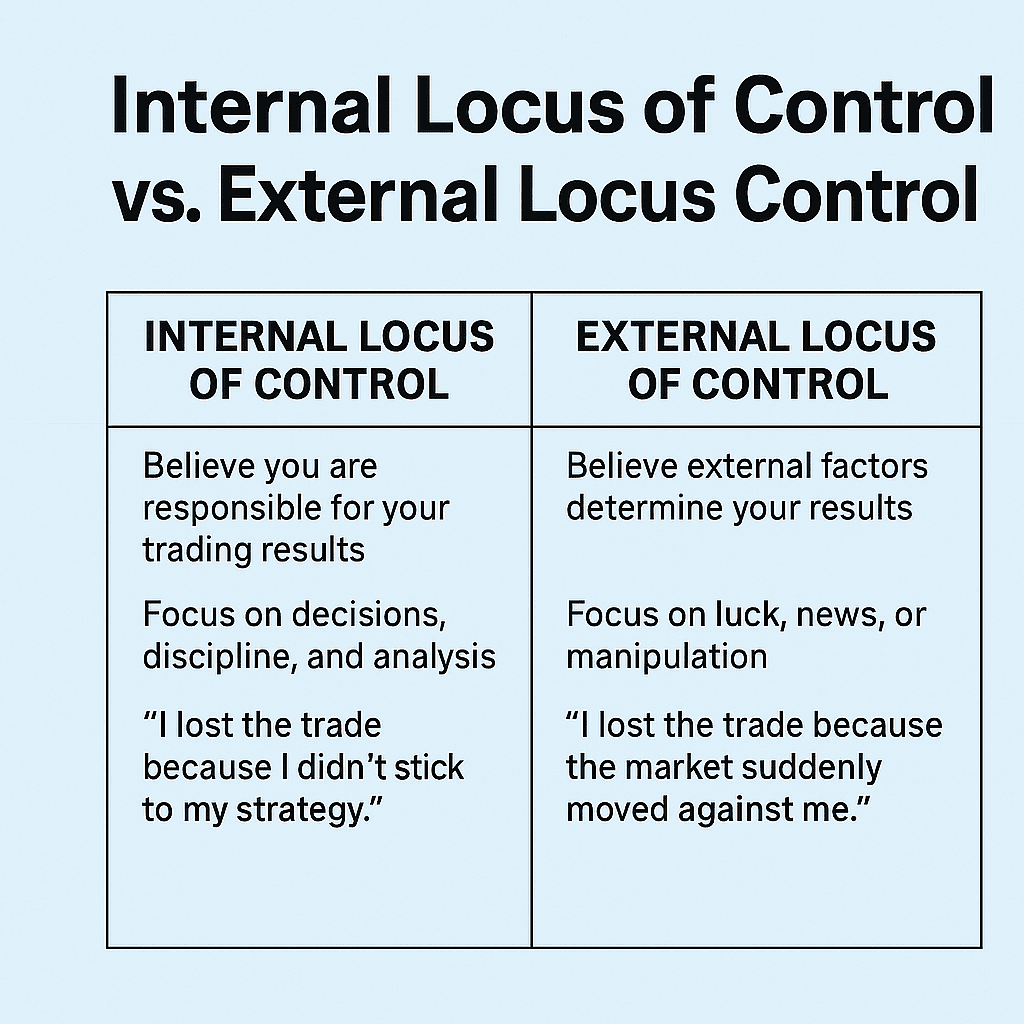1. Introduction:
In the world of trading, success is not only about technical analysis or capital management — it also depends on your mindset and how you perceive control over your results. This is where the concepts of “Internal Locus of Control” and “External Locus of Control” come into play, forming an important part of trading psychology.
2. Definition of the Two Concepts:
A. Internal Locus of Control:
This is the belief that you are directly responsible for your trading results.
You see your decisions, discipline, and market analysis as the key factors that determine profit or loss.
Example: “I lost the trade because I didn’t stick to my strategy.”
B. External Locus of Control:
This is the belief that your results depend on external factors you cannot control.
You see luck, news events, or market manipulation as the main drivers of outcomes.
Example: “I lost the trade because the market suddenly moved against me due to some news.”
3. Impact of Each Type on the Trader:
A trader with an internal locus of control takes responsibility for their actions, stays disciplined in following their strategy, and improves quickly by learning from mistakes.
A trader with an external locus of control takes less responsibility, is more influenced by emotions, and develops slowly because they blame circumstances or the market instead of reviewing their performance.
4. Why This Matters in Trading:
A trader with an internal locus learns from mistakes and improves their strategy, while one with an external locus tends to blame conditions or the market, which hinders growth.
Sustainable success in trading requires a balance: acknowledging that you control your decisions while also accepting that external factors may influence the outcome.
5. How to Develop an Internal Locus of Control in Trading:
1. Record every trade along with the reasons for entry and exit.
2. Evaluate yourself instead of blaming the market when you lose.
3. Learn from mistakes by reviewing your performance regularly.
4. Set a clear trading plan and stick to it.
5. Accept that the market is beyond your control, but your decisions are within your control.
6. Practical Examples:
Example 1: After a Losing Trade:
Internal locus: “I entered the trade too late; I should have waited for a confirmed breakout before buying.” → Reviews their strategy to avoid repeating the mistake.
External locus: “The market moved against me suddenly; this is just bad luck.” → Makes no adjustments or improvements.
Example 2: After Making Profits:
Internal locus: Acknowledges that profits came from following the plan and being disciplined in risk management.
External locus: Believes profits were only due to luck or a favorable news event.
Example 3: Facing Unexpected News:
Internal locus: Accepts that news is part of the market and plans risk management strategies for such events.
External locus: Blames news for every loss and considers trading pointless against “uncontrollable forces.”
7. Conclusion:
Internal and external locus of control reflect your mindset as a trader.
If you want to improve quickly, adopt an internal locus of control — but remember that even with the best planning, there will always be external factors you cannot control.
The key is adapting to these factors instead of using them as an excuse to stop progressing.
That's all for to day i hope you found this helpful.😇
Please give me a like 👍and follow the page🔔 for more.
If you have any questions leave them in the comments and I'll reply to everyone. 💬
Thank you. 🙏

#BinanceSquareFamily #Binance #LearnFromMistakes #lessonlearned #LearnCrypto



